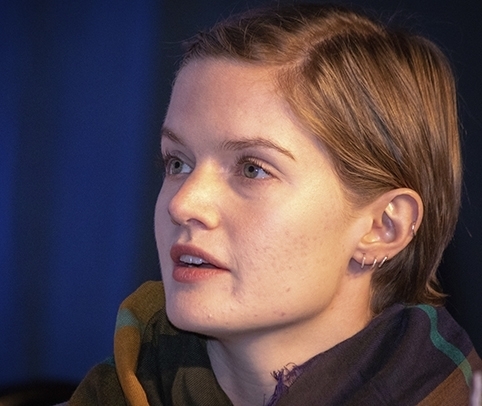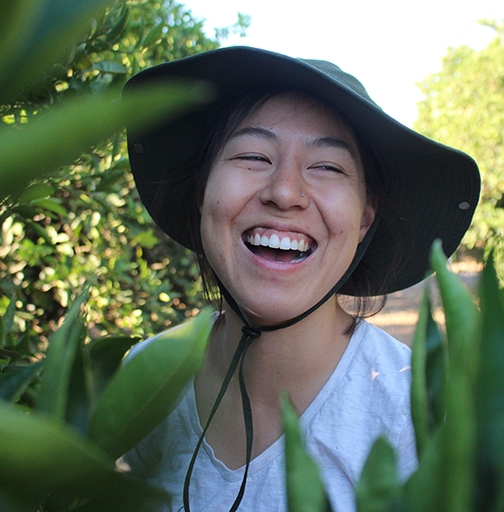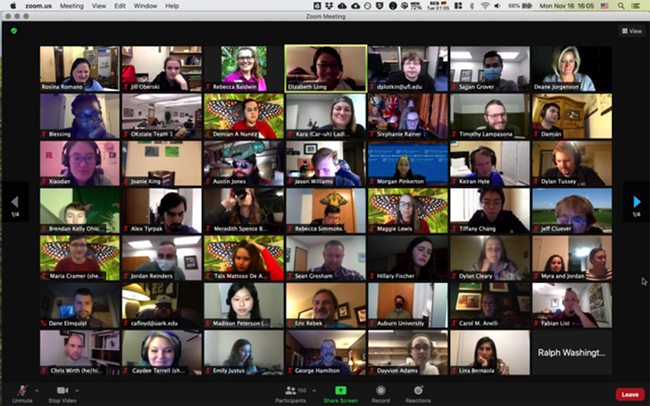
"A worker honey bee has how many pairs of wax glands on its abdomen?"
That would be four, answered the UC Davis Entomology Team did at the Entomological Society of America's Virtual Entomology Games, a college-bowl type of competition formerly known as the Linnaean Games.
Doctoral students Jill Oberski, Zachary Griebenow and Hannah Kahl of the UC Davis Department of Entomology and Nematology teamed to compete in Games, a fun and lively event but this year it went virtual due to COVID-19 pandemic precautions.
Oberski and Griebenow are both fourth-year doctoral students in the Phil Ward lab, while Kahl, a member of the Jay Rosenheim lab, is currently a third-year doctoral student who will begin her fourth year in January.
The UC Davis team won its preliminary round and then entered the highly competitive finals, placing 11th. Alabama's Auburn University edged the Boiler Bugs of Purdue to win the championship.

The champions, from Auburn University's Department of Entomology and Plant Pathology, answered 27 of the 40 questions correctly, tying with the Boiler Bugs of Purdue, “but Auburn had the closest answer for the tiebreaker question,” Rominiecki said.
In the Entomology Games, teams of two to four students test their entomological knowledge by answering questions drawn from all disciplines of insect science: behavior and ecology, biological control, entomology in culture, integrated pest management (IPM) and insect/plant interactions, medical and veterinary entomology, biochemistry and toxicology economic entomology, history of entomology, morphology and physiology, and systematics and evolution.

ESA did not record the Games this year, as the event itself “was mostly just a recitation of the questions, without the more lively 'buzzing in' format of the live event,” Rominiecki related.
“All in all, we were pleased with how the Entomology Games went this year, in an entirely new format," he said. "Our organizers worked hard in just a few short months to create a virtual version of the Games, and it was great to have teams from all over the country participating as usual, despite the new circumstances. We look forward to returning to an in-person event in the future, of course, but the 2020 virtual edition will be a memorable one. Congratulations to Auburn on their victory, and kudos to all the teams who participated!”

- Keye Luke, Jay Chou, and Bruce Lee have all portrayed Kato, the crimefighting partner of what fictional vigilante?
- What is the full scientific name (genus and species) of the bacterium classified by IRAC as a microbial disruptor of insect midgut membranes?
- "Yoke-winged" is the literal translation of the name of what insect suborder, which can be distinguished from other members of its order by the presence of caudal gills on the aquatic immatures?
- Although this year's festivities were postponed due to COVID-19, the small town of Point Pleasant, West Virginia, normally hosts an annual festival that commemorates the 1966 sightings of what paranormal figure?
- A widely-publicized 2017 study reported a 75 percent decline in insect biomass over the past 27 years. This study was conducted across 63 protected natural areas in what European country?
- What striking form of structural coloration involves color changes based on the angle of the observer, and was recently shown to help jewel beetles camouflage in order to avoid bird predation?
- These specialty loaves of bread are labeled "kuwagata," which is a Japanese word that refers to insects in what family?
- "Stimulo-deterrent diversion" was one of the earlier names for what IPM strategy that uses volatile cues from both repellent and attractant plants to reduce damage from insect pests?
- The megalopteran family Corydalidae is divided into two clades: Corydalinae (aka dobsonflies) and what other subfamily, whose members are commonly known as fishflies?
- Bombykol and bombykal are components of a sex pheromone emitted by certain females in what insect order?
- What term refers to a parasitoid that halts the development of its host shortly after the initial parasitization?
- Paederus dermatitis, also known as whiplash dermatitis, is a type of skin irritation caused by contact with the hemolymph of certain species in what insect family?
- What type of semiochemical benefits the receiver and harms the emitter?
- What sixteen-letter adjective is most commonly used to describe fungi and nematodes that can potentially act as biological control agents of insect pests?
- Of the three types of lobes typically found in an insect brain, which lobe innervates the labrum and foregut?
- A 2020 Ig Nobel Prize was awarded to Richard Vetter for collecting evidence that many entomologists exhibit what psychological condition? This condition is also the title of a movie that won the 1990 Saturn Award for Best Horror Film.
- What twelve-letter term was coined by entomologist Willi Hennig to refer to a derived character that is shared between multiple species and their most recent common ancestor?
- The first sighting of emerald ash borer in North America occurred in 2002, when it was discovered attacking ash trees in Ontario, Canada and what U.S. state?
Answers:
- Green Hornet
- Bacillus thuringiensis
- Zygoptera
- Mothman
- Germany
- Iridescence
- Lucanidae
- Push pull
- Chauliodinae
- Lepidoptera
- Idiobiont
- Staphylinidae
- Kairomone
- Entomopathogenic
- Tritocerebrum
- Arachnophobia
- Synapomorphy
- Michigan
The tiebreaker question? It dealt with the number of Far Side comics referencing insects. The question: "Gary Larson is known for using insects as a source of humor in his acclaimed comic strip 'The Far Side.' A survey of 4,300 'Far Side' comics revealed that exactly how many contained some sort of entomological reference?" Answer: 359.
Over the last few years, UC Davis teams have won the national championship three times in the fun and lively competitions. (See Bug Squad blog)
"Hopefully, we can be back onstage in person next year," said Oberski.
Attached Images:
